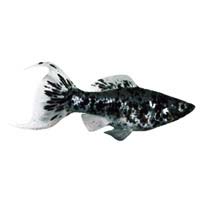Molly - Marble
Black Lyretail Molly, Marble Lyretail Molly Scientific Name: Poecilia sphenops
Mon, 25th November, 2024 - 9:42 pm GMT
Sponsor Ads:

Alternative Name
Black Lyretail Molly, Marble Lyretail Molly Scientific Name: Poecilia sphenopsBasic Info
Male Lyretail Mollies usually have more elongated bodies than females, who have round bellies. Males grow to about three inches (eight centimeters), and females grow to about five inches (12.5 centimeters). The interesting appearance of the Lyretail Molly can be attributed to its tail, for the most part. The tails are large, and lyre shaped, as the name suggests. They extend in a graceful curve away from the fish's body. The ends of the tail taper into sharp points. Lyretail Mollies have pointed mouths, like most Mollies. Although Lyretail Mollies are available in a number of colorings, Black and Marble are two more common patterns. Black Lyretail Mollies are usually more of a dark brown than black in color, and their sides often have a sheen of green or blue. Brown or orange dots may also be present on the sides of these fish. Marble Lyretail Mollies have a beautiful silvery background color, which is marbled, dotted, or splotched with black
Health
Lyretail Mollies usually do well when kept in temperatures between 68 and 77 degrees Fahrenheit. They may prefer slightly saline waters. Hiding places like rocks, a few pieces of driftwood, or plenty of live plants should be offered. Lyretail Mollies are usually quite peaceful. They normally get along well with their own species and usually do well when kept in a ratio of two females for each male. Many people maintain their Lyretail Mollies nicely on flake or freeze-dried foods. Fresh spinach, lettuce, peas, and zucchini bits are also offered. Fresh or frozen bloodworms, glass worms, and brine shrimp can be offered, along with live tubifex worms. Frozen daphnia, plankton, and vegetable diet are all commonly fed. Breeding Male Lyretail Mollies have more pointed dorsal fins than females, and they have gonopodiums, which are mating structures. These organs have the appearance of fins folded against the bottoms of their bodies. It is thought that they develop from anal fins. Females also tend to have rounder bellies than males. Usually, Lyretail Mollies are ready breeders. Lyretail Mollies bear live young. However, they may show tendencies to eat their fry. Normally, 20 to 40 young will be born, though much larger numbers are possible. The fry can usually be raised on fine flake food.Habitat
Fresh water fish - they live in both fresh and brackish watersBehavior
The Lyretail Molly is a beautiful, hardy little fish that can make a great beginner's pet. With their impressive shapes, these Mollies can add interest to many freshwater aquariums! Lyretail Mollies are usually non-aggressive and can be nice additions to community tanks. They tend to swim in all levels of an aquarium and do well in groups, particularly in groups of their own species. In the wild, they live in both fresh and brackish waters. In captivity, Lyretail Mollies should be kept in aquariums with lots of live plants and lots of open space to swim in. Although some driftwood is acceptable in their tanks, too much can make the water more acidic than is preferable for Lyretail Mollies, and it should be used sparingly.Origin
Central AmericaHistory
Native to Central America, Lyretail Mollies are fairly common in captivity, and are normally available in captive-bred types. Their natural range extends from Mexico to Columbia.Common Foods
N/ASponsor Ads:
A liberal is a man too broadminded to take his own side in a quarrel. --Robert Frost
Molly - Marble
Coded by: BGID® | ALL RIGHTS RESERVED Copyright © 2000-2024
Disclaimer | Privacy | Report Errors / Contact | Credits








 President of the United States of America - Real Estate mogul, Pageant owner and now one of the most controversial men in political history.
President of the United States of America - Real Estate mogul, Pageant owner and now one of the most controversial men in political history.  Politician, US Vice President and President of the USA - Joseph Robinette Biden Jr.
Politician, US Vice President and President of the USA - Joseph Robinette Biden Jr.  versus
versus  Russia: 'The Evil Empire'? Are they all that bad or is it just the USA trying to portray Russia as bad because they are a world power with land bigger and a society very different from the USA ideal?
Russia: 'The Evil Empire'? Are they all that bad or is it just the USA trying to portray Russia as bad because they are a world power with land bigger and a society very different from the USA ideal?  Global warming has been in and out as the "latest" hot topic for many years. It is, according to modern scientists, the result of man-made industrial pollutants, clearing forested areas, agriculture, etc. But now they are thinking it started way before the Industrial Revolution...
Global warming has been in and out as the "latest" hot topic for many years. It is, according to modern scientists, the result of man-made industrial pollutants, clearing forested areas, agriculture, etc. But now they are thinking it started way before the Industrial Revolution... 
 Corona virus
Corona virus 
 Users with wide screen monitors can benefit from more content on every page.
Users with wide screen monitors can benefit from more content on every page.